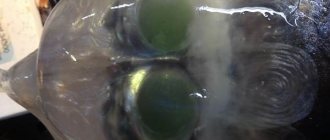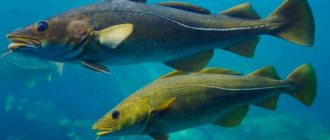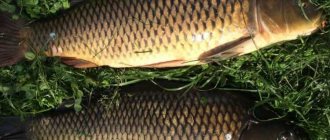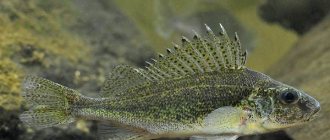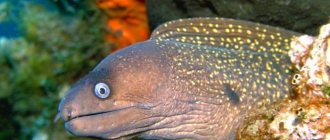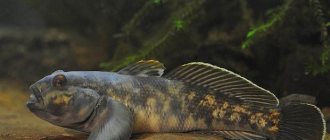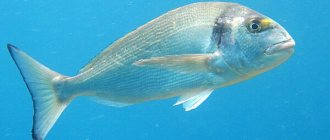Carp is one of the favorite trophies of experienced fishermen. Carp fishing is a special event for which you carefully prepare. In this article I will tell you about the characteristics of this fish, methods of fishing and cooking recipes.
Carp belongs to the carp family, a class of ray-finned fish. This is a large fish with a massive, rounded body. The head is proportional, large with bulging eyes. The powerful mouth is located at the bottom of the head, the upper jaw has a pair of pronounced antennae that are highly sensitive. The nostrils are double and located on top.
The scales are large, smooth, and fit tightly to the skin. The edges of the scales have a dark edging. Some varieties of carp, as a result of selection, have lost their scales or they have turned into skin (naked or leathery carp). The color of the scales largely depends on the type of fish and its habitat.
The body of the carp is covered with abundant mucus.
It performs several functions at once:
- improves gliding in the water column;
- regulates heat exchange;
- protects fish from infections and parasites.
Thanks to the mucus, carp are not so easy to grab with bare hands. Even after death, the scales continue to secrete mucus for some time.
Carps are long-lived. They calmly live up to 45-50 years, and at the same time reach gigantic sizes.
Types of carp
There is a misconception that carp fish is an artificially bred species, the ancestor of which is the carp.
This belief is completely wrong. In fact, carp have always been found in freshwater bodies of water. Those types of carp that lived in running water had a thinner, elongated body. The lake species, living in stagnant bodies of water with a rich food supply, gradually gained weight and increased in size. It was this species that began to be bred in the imperial ponds of China, from where it spread throughout Eurasia. Currently, carps are considered large freshwater fish that live mainly in stagnant water.
There are several varieties of carp:
- Common carp . The species is the most common. It is also called scaly carp, golden carp, etc. The body is massive, round, completely covered with scales. The color is closer to golden or brown; darker specimens are also found. It is this variety that is basic for cultivation under artificial conditions.
- Mirror carp . An exclusively selective species, bred in Germany in the century before last. One of the largest species. The scales do not cover the entire body, but only the upper part or are located along the central line of the body. The scales are very large, shiny, similar to small mirrors (hence the origin of the name).
- Naked (leatherback) carp . The name speaks for itself. There are practically no scales on the body of this type of carp. This species is not as common as others due to its increased vulnerability to infections and parasites.
- Wild carp . This species is found exclusively in natural conditions. It lives in reservoirs only with running water, since it cannot exist in conditions of oxygen starvation. The body of wild carp is highly elongated and covered with mucus. The structure of the muzzle has some similarities with the common carp.
- Koi carp (Japanese carp) . The Japanese are famous for their love of breeding ornamental fish. As a result of selection, they managed to obtain a stable species of carp with exotic colors. These are spotted fish with red and white colors. Morphological characteristics are similar to wild or common carp.
There are even rarer varieties of the carp family: Siamese carp, crucian carp, Chinese crucian carp. All these are hybrid forms.
Useful properties of meat
Industrial cultivation of mirror carp is in particular demand due to the high nutritional value of the meat and its excellent taste. And although the fish is very bony, when cooked it is a real culinary masterpiece. Meat contains many useful vitamins and various microelements that strengthen the immune system and have a positive effect on the functionality of individual internal organs and systems. In addition, the consumption of carp-based dishes is recommended by nutritionists, since they do not contain carbohydrates.
Meat is also good for older people or people with weakened immune systems, as it saturates the body with valuable antioxidants. However, in order to experience the incredible benefits of such a food product, you need to prepare it correctly and also choose good, fresh fish.
Carp size
The size of the carp largely depends on the variety. Wild carp do not grow to gigantic sizes. The average weight of individuals is 3-4 kilograms, but carp fishing is unpredictable; there have also been single specimens weighing up to 10 kg.
Lake species are much larger. Average weight 3-7 kg. But there are documented cases of catching common lake carp weighing more than 55 kg. The common scaly carp is slightly larger than the mirror carp. Japanese varieties do not grow to large sizes. Average weight 1-2 kg.
Diet
When it comes to food, carp is unpretentious; it is deservedly classified as an omnivorous underwater inhabitant. The “telescopic” mouth indicates that it feeds mainly from the bottom, filtering a 20-centimeter layer of soil and selecting nutritional components from it. He easily rubs hard objects with his wide, strong lips.
The daily menu of this fish consists of:
- worms, leeches, insects and their larvae;
- crustaceans and young crayfish (during the molting period);
- shellfish (especially likes barley meat);
- shoots of aquatic plants;
- caviar of all other types;
- larvae of tailless vertebrates (tadpoles).
In the absence of a sufficient amount of food, an adult may instinctively swallow a careless fry, as evidenced by unexpected catches. But carps never consciously hunt for live fish, and therefore are not considered predators.
From all of the above, the conclusion suggests itself: carp is not a gourmet fish. He eats anything he finds edible, making it easy for anyone who wants to catch him.
Carp spawning
Carps reach sexual maturity quite late. Males are able to reproduce in the third year of their life, and females only by the age of five.
Carp spawning occurs late, in late May - early June. This is due to the fact that the water must warm up to a temperature of +18°C. If the spring turns out to be cool, then carp can spawn in mid-June.
For spawning, the female chooses shallow water, where the depth is no more than half a meter. During carp spawning, you can even notice the dorsal fins of large specimens scurrying around in shallow water.
Before spawning, the female acquires several “gentlemen” who accompany her everywhere. The spawning area should be overgrown with thick algae or grass, into which the carp eggs will be deposited. Spawning occurs over several days. Females lay eggs from sunset until the morning.
Appearance and features
The common carp is easily recognizable by many parameters:
- large, thick, slightly elongated body;
- dense, large scales with a dark border; there are from 32 to 41 scales along the lateral line of the fish;
- the sides of the fish are golden, slightly brownish, the thick belly has a lighter tone;
- carp - the owner of a large mouth that extends into a tube;
- the upper lip is decorated with four short antennae, which are very sensitive;
- The fish's eyes are set high, have medium-sized pupils bordered by a greenish-golden iris;
- the powerful fish ridge has a dark shade and a notched fin of a grayish-olive color with a spiny ray, the anal fin is short and also with a spine;
- The nostrils of the carp are double.
Mucus envelops the entire body of the carp, preventing friction, regulating body temperature, and protecting against all kinds of parasites. The carp is very large and very weighty. It is reliably known that specimens weighing more than half a hundredweight and over one and a half meters long were caught. Such sizes are very rare; usually you come across carp from one to five kilograms, their age varies from two to seven years. In general, carp can be considered a long-livers; nature has given it a considerable life span, reaching up to 50 years, and some ornamental species can live for more than a century.
Interesting fact: One seventy-year-old Japanese man has a carp that he inherited, which is 35 years older than its owner. The owner carefully cares for his beloved pet, not agreeing to sell it even for fabulous sums.
Carp habitats
Carp is widespread throughout Eurasia. The habitats of wild varieties of carp are only in running water, as they need a good oxygen balance.
Lake varieties do well in standing water. These can be ponds, lakes, artificial reservoirs. Lake varieties are heat-loving, so they are not found in the northern regions.
The mirror and common species can live in fairly polluted, muddy water. This does not affect their health in any way.
In summer, carp prefer well-warmed areas with a depth of no more than 5 m. The bottom is chosen to be silty or clayey.
Interesting Facts
- The body weight of carp in nature can reach 20 kg, and the length reaches up to a meter.
- There is a known case of longevity (more than 100 years) of this fish (in a home pond).
- Carp chew the shells of river mollusks so loudly that the cracking makes people on the shore flinch.
- In Australia, the introduced common carp has multiplied, infested rivers and is recognized as a dangerous invasive species.
Carp lifestyle
Carp lead a gregarious lifestyle. Young animals gather in large flocks, and adults live solitarily, but still keep their relatives in sight. The young swim in shallow water, in thickets of algae. Large carp live in the depths, rising to the surface only in search of food.
Carps are sedentary inhabitants of water bodies and are not subject to migration. Their habitat is shadow and twilight. Sunny, clean clearings without algae are not for them.
Carp feeds in the morning and evening. Sometimes it can jump out of the water in search of food. He does this clumsily, leaving behind a lot of splashes and large circles on the water.
Carps are not aggressive. They never share territory, food or females. An important feature of this fish is the ability to see everything around and recognize colors.
In winter, carp are in suspended animation. They go deep, become covered with a thick layer of mucus and fall asleep. Awakening occurs only in spring, when the water temperature reaches 8-10 °C.
Sea or river
This is a non-predatory and omnivorous ichthyofauna, living in stagnant and flowing fresh water bodies, but sometimes fish can meet it in marine waters. Most often, river carp migrate in sea water, living at the mouths of rivers flowing into the sea. Such migrations are carried out by the Danube korop and the Caspian kutum, which enter the waters of the Black Sea and the Caspian Sea and move into estuaries along the coast. But even in the depths of the sea, this non-predatory river fish prefers to move in the freshwater current of the river flowing into the sea. Even the Caspian kutum, which belongs to the carp family, but is not actually a carp, is an inhabitant of freshwater reservoirs.
Life cycle of carp
After the female has laid eggs and the male has fertilized her, the countdown of the carp’s life cycle begins. After about a week, small larvae (no more than 5 mm) hatch from the eggs. For the first 10 days they feed on the yellow sac, which contains all the necessary nutrients. When the yellow sac disappears, the fry begin to feed on their own.
Juveniles live mainly in thickets of grass and algae. Carp grows very quickly, in a year it grows up to 20cm and weighs about 500g. By the age of two years, the carp already weighs more than a kilogram. By the age of 3, males become sexually mature, and females by five. The spawning period begins.
The lifespan of carp is on average 3-8 years. In remote places where there are no fishermen, carp can easily live up to 30 years or more.
Social structure and reproduction
Carp become sexually mature when they are closer to three or five years of age, both males and females. The reproduction of carp depends not only on its age, but also on the temperature of the water and the size of the fish itself. Carp are heat-loving, so they go to spawn closer to the end of May, when the water is already significantly warmed up. For successful reproduction, the length of the male must be at least 30 cm, and the female – at least 37.
The carp chooses a shallow place for spawning (about two meters), usually in reed beds. Such places are difficult to find, so fish return to them several times.
Interesting fact: Carp are not known for their swan fidelity, so the female always has several gentlemen (up to five), who begin fertilization. Peak carp spawning begins at dusk (after the sun has set) and lasts for about 12 hours.
Carps are indeed very prolific. Only one mature female can produce a million eggs, which she lays in portions over several days. The incubation period is only three to six days, then the larvae appear, which feed on the contents of the yolk sac for two to three days. Then, the fry, which begin to swim, eat zooplankton and the smallest crustaceans, actively developing. Closer to six months of age, carp can already weigh about 500 grams. This is how carp grows and develops at such an incredibly fast pace.
Carp fishing methods
Carp fishing methods are not an easy task, especially if the fish are large in size. The main rule is that the tackle must be strong and reliable to withstand the jerks of large fish.
Recently, carp fishing with a feeder has become very popular. The device is simple:
- rigid rod (250-300cm);
- spinning reel;
- heavy feeder. She also plays the role of a sinker;
- leashes with hooks. They can be attached to a “yoke”;
- bite beacon.
You need to fill the feeder with bait (usually porridge or some kind of plant components). Using a fishing rod, the feeder along with the hooks is thrown into the pond. A bite alarm is installed on the fishing rod. That's it, you can rest and wait for the signal. Feeder feeders come in different sizes. The heavier it is, the further you can throw it.
Donka-zakidushka is probably the oldest and most proven method of catching carp. The simplest device is:
- reel;
- strong main line (the length depends on the specific body of water, but it is better to take it with a reserve);
- several leashes with hooks;
- heavy sinker (allows the hooks to stay in one place);
- bite beacon.
The fishing method is simple. A fishing line with a sinker and hooks is thrown onto the feeding area. You need to attach a bite alarm to the main line. This type of tackle can also be attached to a fishing rod with a tape measure.
The float rod is also popular when fishing for carp.
For it you will need the following gear:
- durable fishing rod (5-6 m). It is better not to skimp on it, since when nursing a large specimen, the flimsy tackle may simply break;
- reel with clutch;
- float;
- cut pellets for proper loading of the float;
- hooks;
- fishing line The main one should be thicker, the leashes should be thinner.
We attach the bait, throw the tackle into the feeding area and wait for a bite.
These were the three most popular ways to catch carp. Depending on the region, gear may have design features.
Description
The carp fish belongs to the class of ray-finned fish, the order Cyprinidae, and the family Cyprinidae. It is found everywhere in river or lake fresh water. More than 130 species of this fish are found on the territory of Russia and the former countries of the USSR. Various carp can be both predatory and those that feed exclusively on freshwater vegetation. Although there are also omnivorous specimens.
The first specimen of the common carp was discovered by scientists 2000 years ago in the Danube basin. During this period of its existence, it became so successful that it can now be found almost everywhere, with the exception of the poles.
It began to be bred en masse to obtain a fish food base in Europe in the period from the 12th to the 13th centuries. Monks began stocking it and their work became so successful that within just a few 100 years this fish became dominant in the vast majority of freshwater basins in Europe and Asia.
Although, according to other sources, it was the Asians who were the first to grow this fish to obtain a complete source of protein. And this happened several thousand years ago.
But today, due to its rapid reproduction and unpretentiousness, this fish is included in the list of the 100 most invasive species that can negatively affect the local aquatic population.
When describing carp, it is worth highlighting the following features of this fish:
- The body is thick and quite high.
- The body color is predominantly golden or yellow-brown with a lighter belly. The back is dark, crowned with a notched fin.
- The fins themselves have a different color - they can be dark green or swamp.
- The fish's eyes are set high on its head. The pupils are small in size and have a golden-green iris.
- Describing the structure of the head, it is worth noting that the nostrils of the fish are double.
- The lips are quite pronounced. And along the top of them there are 2 pairs of small but pronounced antennae, which have a high level of sensitivity.
- The body of the fish is covered with thick mucus, including the fins. It is this kind of protection that allows you to minimize the force of friction on the water, optimize the thermoregulation of the carp and protect its body from the penetration of various parasites and infections from the outside.
- When describing the structure of carp, we can highlight the fact that the scales of this fish look quite impressive. It is large, dense, flat in shape - especially on the lateral parts of the body.
- Length – it can vary significantly among different types of cyprinids. This parameter also depends on the age of the fish. Most often, body length varies from 20 cm to 1 m.
- Large fish can reach a body weight of 50 kg or more.
- Fish live in rivers, lakes, and small streams. Life expectancy depends on the habitat. There are individuals that have reached the age of 50 years or more. Although, there are several ornamental varieties of carp that, in a favorable habitat, are able to overcome the age limit of 100 years.
External structure
When describing the average external structure, it is necessary to highlight such features of the fish as:
- Wide, vertically rounded body, flattened on the sides.
- Predominantly warm yellowish-golden coloration with dark upperparts and fins.
- The scales are large and may have an uneven size on different parts of the body. But it always fits tightly to the skin.
- The head of both males and females is large, with a well-defined and developed mouth and lips. There is a pair of short antennae along the upper lip that act as a sensitive organ.
- When describing the body coloring features of this fish, it is worth noting that carp can be either lighter or almost black. It all depends on the type of fish and the characteristics of the habitat.
Internal structure
Moving on to the description of the internal structure of this fish, it is worth highlighting the following differences:
- Like many bony fish, carp have a swim bladder, which helps to change the depth of their dive. This special bag is filled with air and is attached above the intestines. Thanks to the presence of a swim bladder, the carp manages to reduce energy costs in terms of diving to depth. Although numerous studies have shown that if this fish for some reason loses its swim bladder, it lives in its usual way.
- The kidney is the most important organ of a fish, as its main function is to constantly pump water.
- It is also worth noting that carp, like any other fish, accepts the ambient temperature. And so that the fish has the opportunity to survive in any conditions, the heart ensures the pumping of blood to all parts of the body. And it is located directly behind the gill covers and takes maximum oxygen from this organ, which has very thin walls and a mass of capillaries.
- In small individuals, breathing occurs more often than in large fish. Therefore, they react more painfully to any environmental pollution. After all, all dissolved toxins and pollutants enter the bloodstream faster, which means they poison the body.
- The intestines of carp are represented by a very long intestine, which helps break down the food they eat with the help of a sufficient amount of enzymes. It is worth noting that this type of fish does not have a stomach. The intestine is directly attached to the esophagus and the environment inside it is intensely alkaline with a pH of 7 to 7.7. Although, modern scientists point out that the level of the alkaline environment of this organ depends on the temperature of the water and can vary significantly depending on the calendar period of the year.
- From the point of view of the body’s response to external and internal conditions, carp has a central nervous system, the main functions of which include the transmission of all necessary signals. It is represented by sensory and motor nerve pathways, as well as cerebral nerve pathways, which together provide automatic and situational reactions of fish to a number of specific stimuli. If we consider the brain separately, it is located in the back of the skull. And it directly connects to the spinal cord, which runs along the entire spine through a special channel, which protects it from unexpected damage. An interesting fact is that this fish, like other orders, has a well-developed long-term memory, which is responsible for the accumulated experience and its further use in everyday life. Which contributes to survival, even under changing conditions.
The difference between a female and a male
The male differs from the female in the anus. In males it is elongated from head to tail and has the shape of a triangular fold. In the female it is oval.
The onset of sexual maturity in males occurs at 2-3 years, and in females at 3-4 years of age.
Another interesting fact is the difference between fish during the breeding season. Males look brighter during this period. Their color changes significantly; a pinkish coating appears on the body. At this moment, a male corpus can also be distinguished by the outgrowths that appear in the area of the back and fins.
Females mostly remain without external changes.
Carp baits
Carp baits are divided into three large groups:
- Plant origin. These include corn and peas, sometimes you can use large pearl barley. Flavored dough and bread have worked well.
- Animal origin. These are all kinds of worms, bloodworms, caterpillars, pieces of meat. As a rule, such bait is effective in mid-summer.
- Artificial origin. These are all kinds of flies, jigs, etc. Nowadays you can often find such baits in stores.
Many carp anglers make their own baits.
Baits for carp
The right bait for carp is half the success. The place should be well fed; there is no need to skimp on this.
Each fisherman has his own bait mixture recipes. I will tell you about the simplest and most effective ones.
Corn + pearl barley + cake + flavoring. Carp really like the smell of sour grains or legumes. Therefore, we prepare it this way: soak the corn and pearl barley in water for 12 hours. Then drain the water, add flavored oil and cake, mix. All the bait is ready. The recipe is simple, but no less effective.
Peas + cornmeal + flavoring. Peas need to be soaked for a day, and the water needs to be changed. When the peas are ready, mix them with corn flour and add flavoring.
The flavoring for carp also needs to be chosen correctly. Particularly attractive are: garlic, honey, caramel, vanilla.
What does it eat?
All types of carp eat constantly, almost incessantly, from shoots of plants living in the water to frog and fish eggs. This fish has a special structure of the digestive system, not the same as that of other fish. The internal structure of the carp's digestive system is designed in such a way that food continuously moves through the intestines. The speed of food movement depends only on the ambient temperature. The internal structure of the anterior part of the intestine in carp is such that it can greatly change its size, stretching to the maximum or shrinking sharply.
@ vladvitek -depositphotos.com
Therefore, this fish constantly eats everything that is within its reach.
The diet of this omnivorous ichthyofauna includes:
- seaweed;
- reed;
- crustaceans;
- shellfish;
- caviar of freshwater inhabitants;
- insects;
- larvae;
- fry.
When winter ends, carp switches to plant nutrition. In autumn and winter it feeds on animal food.
If carp lives in artificial reservoirs, it eats bread, corn, mixed feed, mucus from coastal algae, and even manure from farm animals, which can enter the reservoir from the shore.
Carp dishes
You can prepare a wide variety of carp dishes:
- baked carp - you can bake it in foil, on the grill, with vegetables, in various sauces. The carp will always be great. It’s not a shame to put such a dish on the holiday table;
- Ukha - you can prepare a rich soup from carp in the kitchen or in the field;
- cutlets - fish cutlets made from river fish - a healthy and dietary dish;
- fried carp - fried carp in a frying pan will not leave anyone indifferent. Tender meat with spices just melts in your mouth.
Cooking from carp is simple, even a novice housewife can handle it.

